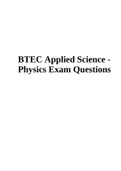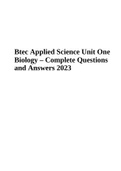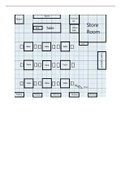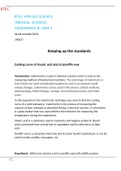Pearson BTEC • Applied Science 2010 QCF
Latest uploads for Applied Science 2010 QCF at Pearson BTEC. Looking for Applied Science 2010 QCF notes at Pearson BTEC? We have lots of notes, study guides and revision notes available for Applied Science 2010 QCF at Pearson BTEC.
-
405
-
23
-
34
Modules Applied Science 2010 QCF at Pearson BTEC
Notes available for the following courses of Applied Science 2010 QCF at Pearson BTEC
- Unit 1 - Fundamentals of Science
- Unit 2 - Working in the Science Industry
- Unit 4 - Scientific Practical Techniques
- Unit 5 - Perceptions of Science
- Unit 6 - Using Mathematical Tools in Science
- Unit 7 - Mathematical Calculations for Science
- Unit 8 - Using Statistics in Science
- Unit 9 - Informatics in Science
- Unit 10 - Using Science in the Workplace
- Unit 11 - Physiology of Human Body Systems
- Unit 12 - Physiology of Human Regulation and Reproduction
- Unit 13 - Biochemistry and Biochemical Techniques
- Unit 14 - Energy Changes, Sources and Applications
- Unit 15 - Microbiological Techniques
- Unit 16 - Chemistry for Biology Technicians
- Unit 17 - Electrical Circuits and their Applications
- Unit 18 - Genetics and Genetic Engineering
- Unit 19 - Practical Chemical Analysis
- Unit 20 - Medical Physics Techniques
- Unit 21 - Biomedical Science Techniques
- Unit 22 - Chemical Laboratory Techniques
- Unit 23 - Science for Environmental Technicians
- Unit 24 - Principles of Plant and Soil Science
- Unit 25 - Electronics for Science Technicians
- Unit 26 - Industrial Chemical Reactions
- Unit 27 - Chemical Periodicity and Its Applications
- Unit 28 - Industrial Applications of Organic Chemistry
- Unit 29 - Physiological Investigations
- Unit 30 - Medical Instrumentation
- Unit 31 - Criminology
- Unit 32 - Forensic Evidence Collection and Analysis
- Unit 33 - Forensic Photography
- Unit 34 - Criminal Psychology
- Unit 35 - Applications of Forensic Psychology
- Unit 36 - Forensic Fire Investigation
- Unit 37 - Forensic Science Informatics
- Unit 38 - Traffic Accident Investigation
- Unit 39 - Criminal Investigation Procedures
- Unit 40 - Criminal Investigation in Practice
- Unit 41 - Clinical Psychology
- Unit 42 - Geology of Natural Resources
- Unit 43 - Diseases and Infections
- Unit 44 - Astronomy
- Unit 45 - Basic Polymer Technology
- Unit 46 - Plastics Materials
- Unit 47 - Plastics Processing
- Unit 48 - Polymer Process Engineering
- Unit 49 - Rubber Products and Specialist Elastomers
- Unit 50 - Rubber Technology
- Unit 51 - Mechanical and Thermal Treatment of Metals
- Unit 52 - Structure and Properties of Metals
- Unit 53 - Extraction and Refining of Metals
Latest content Pearson BTEC • Applied Science 2010 QCF
BTEC Applied Science - Physics Exam Questions. Explain the advantages and disadvantages of using radio waves instead of light waves to send large amounts of information from the satellite to the surface of the Earth. (4 marks) - ANSWER1. Light waves have a higher frequency than radio waves so light waves would take less time to transfer information. 2. Some of the radio waves reach the Earth's surface so they receive a clear signal. Evaluate the strengths and weaknesses of using: • An in...
Btec Applied Science Unit One Biology – Complete Questions and Answers 2023. What is the function of the plasmodestmata? correct answerTo allow materials to pass through the cell wall What is the function of the amyloplasts? correct answerStarch synthesis and storage Name three organelles which are only in plant cells correct answerVacuole, chloroplasts, cell wall Define eukaryotic cells correct answerAre part of a multicellular organisms Define prokaryotic cells correct answerAre unicell...
For BTEC Applied Science 2010 QCF, Unit 2, Assignment 2: Laboratory Design. Includes: P3: A lab design M3: Key features of specialist and non-specialist laboratory D2: Essay on why good laboratory design is important for efficiency, effectiveness and safety
BTEC APPLIED SCIENCE (MEDICAL SCIENCE) ASSIGNMENT B, UNIT 2 SILVIA-IULIANA RATA Keeping up the standards Cooling curve of stearic acid and of paraffin wax Introduction: Calorimetry is used in chemical reaction and it is used as the measuring method of biochemical reactions. The advantage of calorimetry is that it does not need complicated equipment, and it can measure small energy changes. Calorimetry can be used in life science, clinical medicine, pharmacology, biotechnology, eco...
public concern animal and civil right groups stem cell research IVF treatment financial matters scientific opinion overseas pressure economic pressures funding for research
healthy diet plan and what each food will do for different aged people alongside recommended amount of exercise.
balanced diet Carbohydrates: Fats: Proteins: Fibre: aids in digestion: Vitamins: s Minerals: Water:
Immune System first line defence second line defence specific response Primary immune response Antibody production Secondary response: memory cell
various screening and their impacts. Evaluate the impact of a vaccine programme on human health. Side Effects of Smallpox Vaccination Normal, Typically Mild Reactions Serious Reactions Life-Threatening Reactions Evaluate the impact of one screening programmes on human health
Anti-Biotics • Broad Spectrum Kill a wide range of bacteria e.g. Penicillin • Narrow Spectrum Kill a specific type or group of bacteria e.g. Isoniazid Antibiotics work in one of two ways • Bactericidal Kills the bacteria • Bacteriostatic Prevents the bacteria from dividing Effects of Ani-biotics Beta-lactam Effects of ani biotics Macrolides Effects of Anti- biotics Quinolones Gene Therapy










